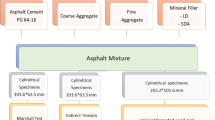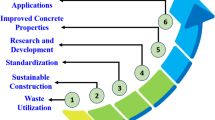Abstract
The current study examines the effective use of bottom ash, which is mixed with lime and sodium hexametaphosphate (SHMP), to stabilize the expansive soil in order to make a composite subgrade material for flexible pavement design. The study involves performing laboratory tests on expansive soil samples containing bottom ash and lime alone and along with (NAPO3)6. The tests such as differential free swell, consistency limits, compaction characteristics, unconfined compressive strength tests and California bearing ratio are performed. The results showed that adding an optimal amount of bottom ash (15%), lime (6%), and (SHMP) (4.5%), both alone and in combination, reduces the differential free swell and consistency limits of expansive soil and increased the CBR values, accomplishing it into an effective subgrade material. The thickness of flexible pavement was designed using IITPAVE software. The design was done by utilising obtained CBR values, it met the required parameters based on the IRC: 37-2018 recommendations. The software analysis revealed a reduction in pavement thickness for different commercial vehicle traffic volumes (1000, 2000, and 5000), with the highest reduction in layer thickness and construction costs observed when expansive soil was combined with bottom ash (15%), lime (6%), and (SHMP) (4.5%). This technology not only improves the geotechnical characteristics of subgrade soil, but it is also cost-effective and tackles the bottom ash disposal issue. Overall, this research proposes a novel method for developing a composite soil subgrade material for flexible pavement.


















Similar content being viewed by others
References
Al-Taie A et al (2023) Mechanical and physical properties and cyclic swell-shrink behaviour of expansive clay improved by recycled glass. Int J Pavement Eng 24(1):2204436
Anand D, Sharma RK, Sharma A (2021) Improving swelling and strength behavior of black cotton soil using lime and quarry dust. In: Sustainable development through engineering innovations: select proceedings of SDEI 2020. Springer, Singapore
Athanasopoulou A (2014) Addition of lime and fly ash to improve highway subgrade soils. J Mat Civil Eng 26(4):773–775
Anburuvel A et al (2023) Characteristic evaluation of geopolymer based lateritic soil stabilization enriched with eggshell ash and rice husk ash for road construction: an experimental investigation. Constr Build Mater 387:131659
Bhardwaj A, Sharma RK (2020) Effect of industrial wastes and lime on strength characteristics of clayey soil. J Eng Des Technol 18(6):1749–1772. https://doi.org/10.1108/JEDT-12-2019-0350
Bhardwaj A, Sharma RK, Sharma A (2021) Stabilization of clayey soil using waste foundry sand and molasses. In: Sustainable development through engineering innovations: select proceedings of SDEI 2020. Springer, Singapore
Bhardwaj A, Sharma RK (2022) Designing thickness of subgrade for flexible pavements incorporating waste foundry sand, molasses, and lime. Innov Infrastruct Solut 7(1):132
Bhatt M et al (2021) Valorization of solid waste using advanced thermo-chemical process: a review. J Environ Chem Eng 9(4):105434
Bhurtel A, Eisazadeh A (2020) Strength and durability of bottom ash and lime stabilized Bangkok clay. KSCE J Civ Eng 24:404–411
Bose B (2012) Geo engineering properties of expansive soil stabilized with fly ash. Electron J Geotech Eng 17(1):1339–1353
Bozbey I, Garaisayev S (2010) Effects of soil pulverization quality on lime stabilization of an expansive clay. Environ Earth Sci 60(6):1137–1151
Chauhan MS, Mittal S, Mohanty B (2008) Performance evaluation of silty sand subgrade reinforced with fly ash and fibre. Geotext Geomembr 26(5):429–435
Dash SK, Hussain M (2012) Lime stabilization of soils: reappraisal. J Mater Civ Eng 24(6):707–714
Dash SK, Hussain M (2015) Influence of lime on shrinkage behavior of soils. J Mat Civil Eng 27(12):04015041
Edil TB, Acosta HA, Benson CH (2006) Stabilizing soft fine-grained soils with fly ash. J Mater Civ Eng 18(2):283–294
Eskioglou P, Oikonomou N (2008) Protection of environment by the use of fly ash in road construction. Glob NEST J 10(1):108–113
Fırat S et al (2012) Utilization of marble dust, fly ash and waste sand (Silt-Quartz) in road subbase filling materials. KSCE J Civ Eng 16:1143–1151
Forteza R, Far M, Seguı C, Cerdá V (2004) Characterization of bottom ash in municipal solid waste incinerators for its use in road base. Waste Manage 24(9):899–909
Gautam KK, Sharma RK, Sharma A (2021) Effect of municipal solid waste incinerator ash and lime on strength characteristics of black cotton soil. In: Sustainable development through engineering innovations: select proceedings of SDEI 2020. Springer, Singapore
HPPWD (2020) Schedule of rates. Himachal Pradesh Public Works Department, Shimla
IS 1498 (1970) Classification and identification of soils for general engineering purpose
Ikeagwuani CC, Obeta IN, Agunwamba JC (2019) Stabilization of black cotton soil subgrade using sawdust ash and lime. Soils Found 59(1):162–175
IS 2720 Part 40 (1977) Methods of tests for soil, part 40. Determination of free swell index of soil. Bureau of Indian Standards, New Delhi
Jha AK, Sivapullaiah PV (2016) Volume change behavior of lime treated gypseous soil—influence of mineralogy and microstructure. Appl Clay Sci 119:202–212
Krithiga N, Pujitha D, Palayam T, Revathy Sri Muthukumaran A (2016) Soil stabilization using lime and fly ash 8
Kumar S, Stewart J (2003) Utilization of Illinois PCC dry bottom ash for compacted landfill barriers. Soil Sedim Contam 12(3):401–415
Kumar GRMA, Raju GVRP (2014) Swelling properties of expansive soils treated with chemicals and flyash. Am J Eng Res 4:245–250
Kumar N, Sharma A, Singh K (2022) Influence of pond ash on compaction and strength of clayey soil mixed with terrazyme. In: Advances in construction materials and sustainable environment: select proceedings of ICCME 2020. Springer, Singapore
López EL et al (2015) Bearing capacity of bottom ash and its mixture with soils. Soils Found 55(3):529–535
Moghal A, Sivapullaiah P (2012) Role of lime leachability on the geotechnical behavior of fly ashes. Int J Geotech Eng 6(1):43–51
Nabizadeh Mashizi M et al (2023) Mechanical and microstructural properties of a stabilized sand using geopolymer made of wastes and a natural pozzolan. Sustainability 15(4):2966
Prabakar J, Dendorkar N, Morchhale RK (2004) Influence of fly ash on strength behavior of typical soils. Cons Build Mat 18(4):263–267
Phani Kumar BR, Sharma RS (2004) Effect of fly ash on engineering properties of expansive soils. J Geotech Geoenviron Eng 130(7):764–767
Sezer A et al (2006) Utilization of a very high lime fly ash for improvement of Izmir clay. Build Environ 41(2):150–155
Sharma A, Sharma RK (2019) Effect of addition of construction–demolition waste on strength characteristics of high plastic clays. Innov Infrastruct Solut 4(1):27
Sharma A, Sharma RK (2020) Strength and drainage characteristics of poor soils stabilized with construction demolition waste. Geotech Geol Eng 38(5):4753–4760
Sharma A, Sharma RK (2021a) An experimental study on uplift behaviour of granular anchor pile in stabilized expansive soil. Int J Geotech Eng 15(8):950–963
Sharma A, Sharma RK (2021b) Sub-grade characteristics of soil stabilized with agricultural waste, constructional waste, and lime. Bull Eng Geol Env 80(3):2473–2484
Singh M, Singh K, Sharma A (2022) Strength characteristics of clayey soil stabilized with brick kiln dust and sisal fiber. In: Advances in construction materials and sustainable environment: select proceedings of ICCME 2020. Springer, Singapore
Sudhakaran SP, Sharma AK, Kolathayar S (2018) Soil stabilization using bottom ash and areca fiber: Experimental investigations and reliability analysis. J Mat Civil Eng 30(8):04018169
Verma V, Abhishek (2019) Stabilization of clayey soils using fly ash and RBI grade 81. In: Proceedings of the 1st international conference on sustainable waste management through design: IC_SWMD 2018 1. Springer International Publishing, pp 95–102
Zagvozda M, Rukavina T, Dimter S (2022) Wood bioash effect as lime replacement in the stabilisation of different clay subgrades. Int J Pavement Eng 23(8):2543–2553
Zhu F, Li Z, Dong W, Yangyun Ou (2019) Geotechnical properties and microstructure of lime-stabilized silt clay. Bull Eng Geol Environ 78(4):2345–2354
Author information
Authors and Affiliations
Contributions
SR have done all the experiments in the laboratory physically and written the manuscript with the help of other authors. SS have given the guidance in writing manuscript. AS give his contribution in whole laboratory work and also helped in writing manuscript.
Corresponding author
Ethics declarations
Conflict of interest
There is no conflict of interest associated with the manuscript.
Additional information
Publisher's Note
Springer Nature remains neutral with regard to jurisdictional claims in published maps and institutional affiliations.
Rights and permissions
Springer Nature or its licensor (e.g. a society or other partner) holds exclusive rights to this article under a publishing agreement with the author(s) or other rightsholder(s); author self-archiving of the accepted manuscript version of this article is solely governed by the terms of such publishing agreement and applicable law.
About this article
Cite this article
Rana, S., Singh, S. & Sharma, A. Utilizing bottom ash, lime and sodium hexametaphosphate in expansive soil for flexible pavement subgrade design. Multiscale and Multidiscip. Model. Exp. and Des. (2023). https://doi.org/10.1007/s41939-023-00210-8
Received:
Accepted:
Published:
DOI: https://doi.org/10.1007/s41939-023-00210-8




